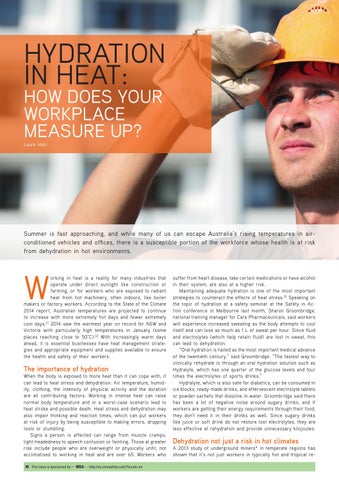HYDRATION IN HEAT: HOW DOES YOUR WORKPLACE MEASURE UP? Laura Valic
Summer is fast approaching, and while many of us can escape Australia’s rising temperatures in airconditioned vehicles and offices, there is a susceptible portion of the workforce whose health is at risk from dehydration in hot environments.
W
orking in heat is a reality for many industries that operate under direct sunlight like construction or farming, or for workers who are exposed to radiant heat from hot machinery, often indoors, like boiler makers or factory workers. According to the State of the Climate 2014 report, Australian temperatures are projected to continue to increase with more extremely hot days and fewer extremely cool days.[1] 2014 saw the warmest year on record for NSW and Victoria with particularly high temperatures in January (some places reaching close to 50°C).[2] With increasingly warm days ahead, it is essential businesses have heat management strategies and appropriate equipment and supplies available to ensure the health and safety of their workers.
The importance of hydration When the body is exposed to more heat than it can cope with, it can lead to heat stress and dehydration. Air temperature, humidity, clothing, the intensity of physical activity and the duration are all contributing factors. Working in intense heat can raise normal body temperature and in a worst-case scenario lead to heat stroke and possible death. Heat stress and dehydration may also impair thinking and reaction times, which can put workers at risk of injury by being susceptible to making errors, dropping tools or stumbling. Signs a person is affected can range from muscle cramps, light-headedness to speech confusion or fainting. Those at greater risk include people who are overweight or physically unfit, not acclimatised to working in heat and are over 65. Workers who 40 This issue is sponsored by — MSA — http://au.msasafety.com/?locale=en
suffer from heart disease, take certain medications or have alcohol in their system, are also at a higher risk. Maintaining adequate hydration is one of the most important strategies to counteract the effects of heat stress.[3] Speaking on the topic of hydration at a safety seminar at the Safety in Action conference in Melbourne last month, Sharon Groombridge, national training manager for Care Pharmaceuticals, said workers will experience increased sweating as the body attempts to cool itself and can lose as much as 1 L of sweat per hour. Since fluid and electrolytes (which help retain fluid) are lost in sweat, this can lead to dehydration. “Oral hydration is hailed as the most important medical advance of the twentieth century,” said Groombridge. “The fastest way to clinically rehydrate is through an oral hydration solution such as Hydralyte, which has one quarter of the glucose levels and four times the electrolytes of sports drinks.” Hydralyte, which is also safe for diabetics, can be consumed in ice blocks, ready-made drinks, and effervescent electrolyte tablets or powder sachets that dissolve in water. Groombridge said there has been a lot of negative noise around sugary drinks, and if workers are getting their energy requirements through their food, they don’t need it in their drinks as well. Since sugary drinks like juice or soft drink do not restore lost electrolytes, they are less effective at rehydration and provide unnecessary kilojoules.
Dehydration not just a risk in hot climates A 2013 study of underground miners* in temperate regions has shown that it’s not just workers in typically hot and tropical re-
